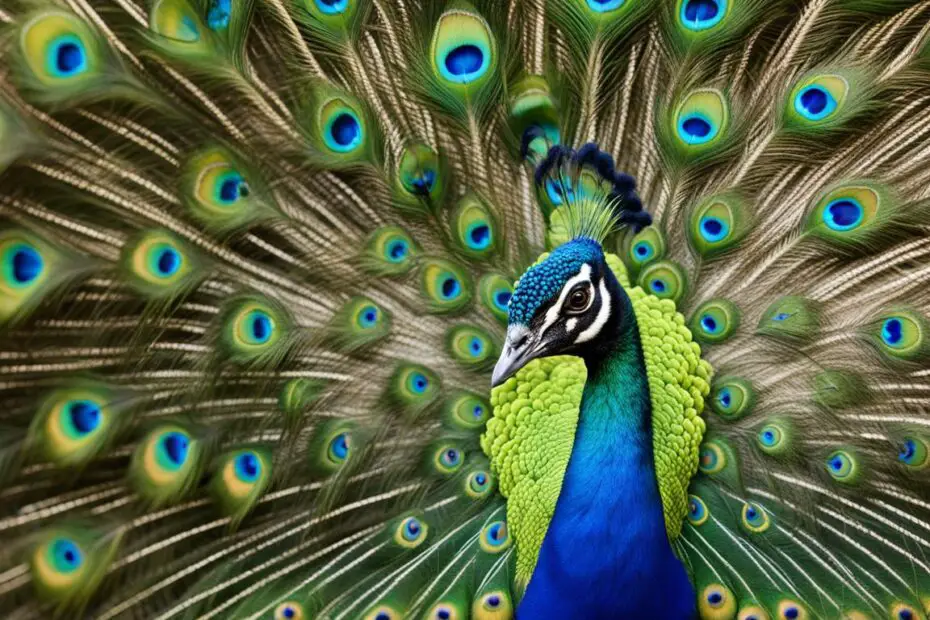Peacocks are known for their vibrant and colorful feathers, but what about baby peacocks? Do they share the same colorful appearance as adults? Let’s dive into the fascinating world of baby peacocks and explore their hues and plumage, shedding light on their appearance, color genetics, and variations.
Baby peacocks have their own unique charm, even though their colors may not be as vibrant as adult peacocks. Their feathers display attractive hues and shades, giving us a glimpse of their future colorful adult plumage.
Understanding the color genetics of baby peacocks can help explain the variations in their plumage and the factors that contribute to their eventual adult colors. Let’s delve into the intriguing world of baby peacock color genetics.
As baby peacocks mature, their feathers gradually develop, and the iconic train begins to form. Witnessing this transformation is a mesmerizing journey of growth and beauty.
In conclusion, baby peacocks may not possess the same vibrant colors as adult peacocks, but they still showcase their own unique charm. Understanding the colorful world of baby and adult peacocks allows us to appreciate the beauty and diversity of these extraordinary birds.
Key Takeaways:
- Baby peacocks have attractive hues and shades in their feathers.
- The color of baby peacocks is influenced by their genetics.
- Baby peacock feathers gradually develop into the iconic train.
- Baby peacocks showcase their own unique charm.
- Understanding baby and adult peacocks’ colors enhances our appreciation of their beauty and diversity.
The Appearance of Baby Peacocks
Baby peacocks have a unique appearance that showcases their charm and beauty. While their colors may not be as vibrant as adult peacocks, they still possess attractive hues in their feathers. Their plumage can vary in shades, with hints of their future colorful adult feathers. Let’s explore the delightful appearance of baby peacocks.
Shades of Baby Peacock Feathers
Although not as vibrant as adult peacocks, the feathers of baby peacocks still exhibit a stunning array of colors. Their plumage can range from soft pastels to muted shades of green and blue. These gentle hues add a touch of elegance and grace to their appearance, captivating observers with their delicate beauty.
Attractive Colors of Baby Peafowls
As baby peacocks develop, their feathers gradually become more pronounced, showcasing a fascinating mix of colors. You may notice glimpses of iridescence and subtle patterns that give a glimpse of the vibrant adult plumage that awaits them. These attractive colors, though more subdued, are a testament to the beauty that lies ahead for these magnificent birds.
The distinctive appearance of baby peacocks is a testament to their future transformation into stunning adult peacocks. While they may not boast the same vibrant colors as their fully grown counterparts, their elegant and alluring appearance is a delightful preview of the colorful world of peafowls.
Table: Comparison of Baby Peacock Colors
| Feather Color | Description |
|---|---|
| Soft Pastels | Baby peacocks display feathers in gentle pastel hues, such as pale blues and pinks. |
| Muted Greens and Blues | The feathers of baby peacocks may feature muted shades of green and blue, hinting at their future vibrant adult colors. |
| Hints of Iridescence | Even as juveniles, baby peacocks may exhibit hints of iridescence, contributing to their overall charm and allure. |
Baby Peacock Color Genetics
Understanding the color genetics of baby peacocks can provide fascinating insights into the variations in their plumage and the factors that contribute to their eventual adult colors. Just like in other animals, the color of baby peacocks is influenced by their genetics. Let’s delve into the intriguing world of baby peacock color genetics.
The Role of Genes
The vibrant colors of adult peacocks are determined by a complex interplay of genes. These genes dictate the production and distribution of pigments in the feathers, resulting in the stunning hues seen in mature peafowls. Baby peacocks inherit these genes from their parents, setting the foundation for their future coloration.
However, the expression of these genes in baby peacocks may not fully reflect their eventual adult colors. This is because the development and maturation of their feathers occur gradually over time. The initial colors of baby peacocks’ feathers may appear dull or muted compared to the vibrant hues of adult peafowls.
Variations in Color
There can be considerable variations in the coloration of baby peacocks, even within the same clutch. These variations can be attributed to the combination of genes inherited from both parents and the presence of genetic mutations. Genetic mutations can lead to unique color patterns and variations, adding to the diversity and beauty of baby peacocks.
The variations in baby peacock coloration serve as a visual representation of the genetic diversity within the species. They highlight the intricate processes that shape the development of their feathers and contribute to the overall visual splendor of adult peafowls.
| Genetic Factors | Color Variation |
|---|---|
| Pigment production genes | Varied intensity of color |
| Distribution of pigments genes | Differences in pattern and arrangement of colors |
| Presence of genetic mutations | Unique color patterns and variations |
As baby peacocks grow and their feathers continue to develop, their colors will become more vibrant and elaborate. Witnessing the transformation from muted tones to the resplendent hues of adult peacock plumage is a testament to the wonders of nature and the intricacies of genetic inheritance.
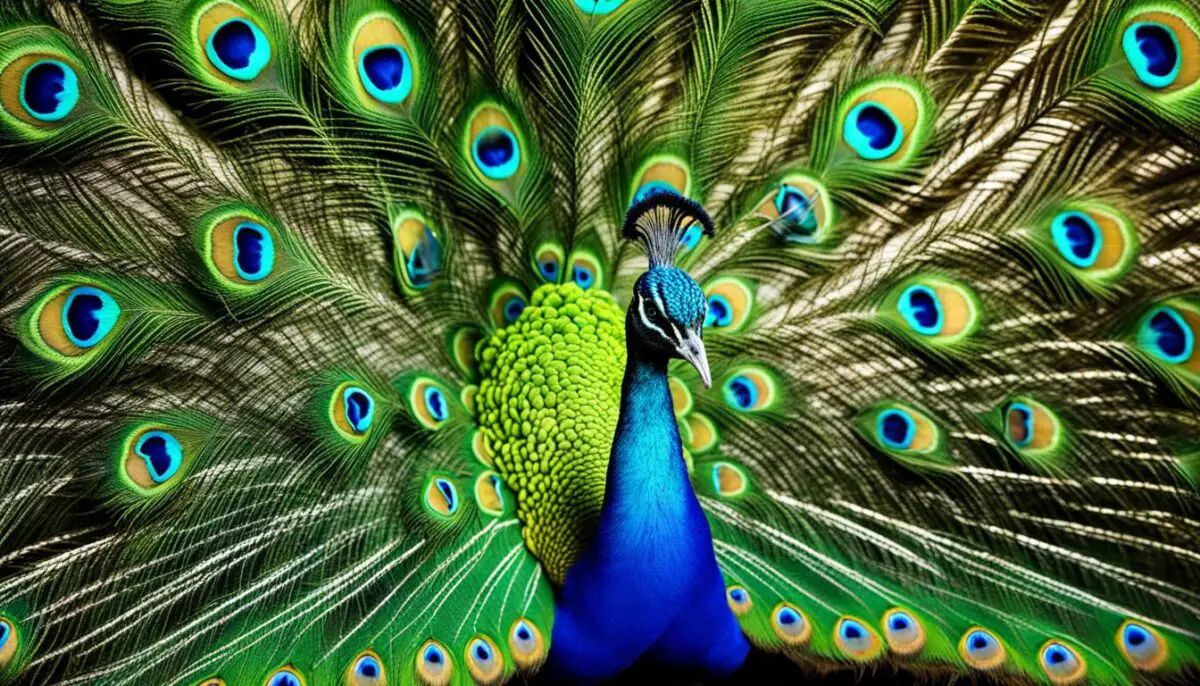
The Colorful World of Adult Peacocks
Adult peacocks are renowned for their vibrant and striking colors, captivating the eyes and imagination of onlookers. Their feathers showcase a mesmerizing array of hues, ranging from vibrant blues and greens to stunning iridescent patterns. The colorful world of adult peacocks is truly a sight to behold, reflecting the beauty and diversity of nature.
The vibrant hues of peacocks are a result of specialized cells in their feathers called melanocytes. These cells contain pigments that reflect light in different ways, creating a stunning display of colors. The intricate patterns and iridescence further enhance their visual appeal, making them one of the most visually striking birds in the animal kingdom.
“The colorful feathers of peafowls are not just visually stunning; they also play an essential role in courtship displays and mate selection. The elaborate and vibrant plumage of male peacocks serves as a signal of their genetic quality and fitness.”
In addition to their feathers, adult peacocks also exhibit vibrant colors in other parts of their bodies. Their heads and necks are adorned with striking shades, while their beaks and eyes feature contrasting hues. These colorful attributes contribute to their overall charm and allure.
| Feather Color | Distinctive Patterns |
|---|---|
| Blue | Eye-like patterns with green and gold accents |
| Green | Bronze shimmering feathers with subtle markings |
| Iridescent | Ever-changing colors under different lighting conditions |
The vibrant colors of adult peacocks serve multiple purposes, including attracting mates, establishing territory, and signaling dominance. These visual displays play a crucial role in their social interactions and reproductive success.
The stunning colors of adult peacocks exemplify the beauty and diversity of nature. Whether observed in the wild or admired in captivity, their vibrant hues continue to captivate the hearts and minds of all who encounter them.
Peacock Feathers and their Structure
Peacock feathers are renowned for their stunning beauty and intricate structure. It is the microscopic arrangement of these feathers that gives them their vibrant colors and captivating patterns. One of the unique features of peacock feathers is the presence of ocelli, or eye-like spots, which play a vital role in the display of feathers during courtship rituals. Let’s take a closer look at the structure of peacock feathers and the fascinating ocelli.
The structure of peacock feathers is composed of several layers. The outer layer, known as the barbs, is what gives the feather its shape. These barbs are attached to a central shaft, known as the rachis, which provides support and stability. It is the arrangement of the barbs and their interlocking structure that creates the feather’s characteristic shape and allows it to fan out in a beautiful display.
Within the barbs are tiny structures called barbules, which further enhance the feather’s structure. Each barbule has a series of branches, known as barbicels, that hook onto neighboring barbules, creating a strong and flexible structure. This interlocking mechanism is what allows the feather to maintain its shape even when exposed to various environmental conditions.
“The structure of peacock feathers is a marvel of nature’s design. The intricate interplay of barbs, barbules, and ocelli creates a visual masterpiece that has fascinated humans for centuries.”
The ocelli on peacock feathers are concentric circles of different colors surrounding a dark center. These eye-like spots are highly reflective and iridescent, creating a mesmerizing effect when light interacts with them. During courtship displays, male peacocks fan out their feathers, showcasing the ocelli to attract potential mates. The vibrant colors and shimmering patterns of the ocelli serve as visual cues that signal the male’s health, strength, and genetic fitness.
| Feather Structure | Description |
|---|---|
| Barbs | Outer layer of the feather that gives it shape |
| Rachis | Central shaft that supports the barbs |
| Barbules | Tiny structures within the barbs that enhance the feather’s structure |
| Barbicels | Branches on the barbules that interlock with neighboring barbules |
| Ocelli | Concentric circles of different colors on the feathers, serving as visual cues during courtship displays |
The intricate structure of peacock feathers, along with the presence of ocelli, contributes to their remarkable beauty. These feathers have long been admired and revered, serving as a symbol of elegance and grace. Whether it is their vibrant colors or their intricate patterns, peacock feathers continue to captivate and inspire us.
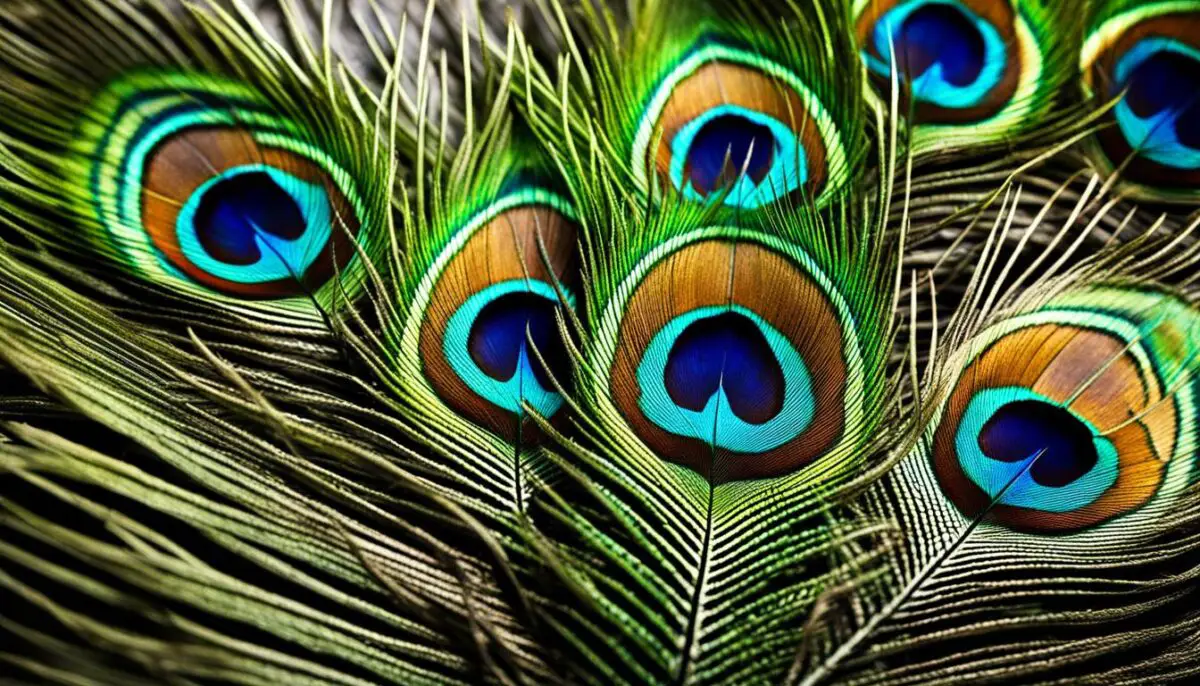
Different Species of Peafowl and their Colors
Peafowls are a diverse group of birds, comprising various species with distinct colors and characteristics. Let’s explore the different species of peafowl and the mesmerizing colors that adorn their plumage.
Indian Peacock
The Indian Peacock (Pavo cristatus) is perhaps the most well-known species, famous for its vibrant and eye-catching colors. Males of this species boast a resplendent train of iridescent blue and green feathers, with striking eye-like patterns called ocelli. These ocelli play a crucial role in attracting mates during courtship displays, creating a mesmerizing spectacle.
Green Peacock
The Green Peacock (Pavo muticus) is native to Southeast Asia and is named for its stunning green and bronze plumage. Unlike the Indian Peacock, the Green Peacock lacks the long train of feathers but compensates with shimmering colors that give it an aura of elegance and sophistication. The males’ feathers showcase a subtle display of greens and blues, captivating observers with their unique charm.
Congo Peacock
Found in the dense rainforests of Central Africa, the Congo Peacock (Afropavo congolensis) is the rarest among the peafowl species. Its deep blue plumage, adorned with bold white stripes, sets it apart from its relatives. Though less known than the Indian and Green Peacock, the Congo Peacock is a true gem of the avian world, its brilliant colors reflecting the beauty of its natural habitat.
| Species | Colors |
|---|---|
| Indian Peacock | Vibrant blue and green; iridescent |
| Green Peacock | Rich green and bronze |
| Congo Peacock | Deep blue with white stripes |
Each species of peafowl showcases its own unique colors, captivating the world with their stunning plumage. From the mesmerizing blues and greens of the Indian Peacock to the elegant shades of green and bronze on the Green Peacock, and the rare and enchanting deep blue of the Congo Peacock, these birds embody the spirit of beauty and diversity in the avian kingdom.
Baby Peacock Development and Feather Growth
Baby peacocks go through a remarkable development process, including the growth of their feathers. As they mature, their feathers gradually develop, revealing hints of the vibrant colors they will display as adults. Understanding the stages of baby peacock development and feather growth provides insights into their eventual appearance and the iconic train that distinguishes them.
The growth of baby peacock feathers is a fascinating journey. At first, their feathers are soft and downy, providing warmth and protection. As they continue to grow, the feathers become more structured, developing the intricate patterns and hues that characterize adult peacocks. This process takes time and patience as the feathers slowly transform into a stunning display.
It is during this development that the iconic train begins to emerge. The train is an elongated display of feathers that extends from the back of the peacock. In baby peacocks, the train is not yet fully formed but starts to take shape as they grow older. Over time, the train feathers lengthen and become more vibrant, creating a magnificent spectacle that captures the attention of all who behold it.
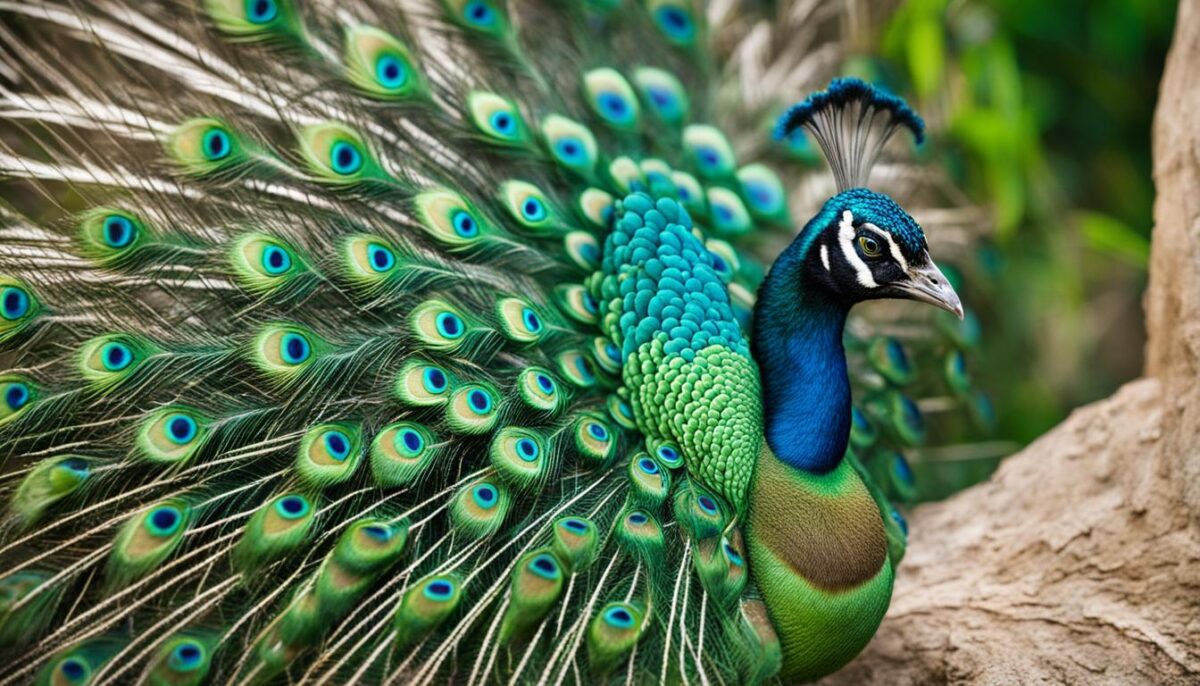
Table: Stages of Baby Peacock Development and Feather Growth
| Stage | Description |
|---|---|
| Egg Hatching | The baby peacock emerges from its egg, covered in soft downy feathers. |
| Downy Feather Stage | The baby peacock’s feathers continue to grow, providing warmth and protection. Feathers are generally dull in color. |
| Emerging Plumage | The baby peacock’s feathers start to develop more structure and begin to display hints of their future vibrant colors. |
| Train Formation | The iconic train feathers gradually emerge, becoming longer and more vibrant as the baby peacock matures. |
As baby peacocks develop and their feathers grow, they undergo a remarkable transformation that eventually culminates in the stunning beauty and vibrant colors of adult peacocks. The growth of their feathers and the emergence of the iconic train are testament to the awe-inspiring journey of baby peacock development.
Survival and Adaptations of Baby Peacocks
Baby peacocks face various challenges in their early stages of life, requiring them to develop specific adaptations to ensure their survival in the wild. These adaptations play a crucial role in helping them navigate their environment and grow into magnificent adults. Let’s explore some of the survival strategies and adaptations that enable baby peacocks to thrive.
Camouflage
One of the key adaptations of baby peacocks is their ability to blend into their surroundings through camouflage. The muted colors and patterns of their feathers help them remain inconspicuous, providing protection from predators. This camouflage allows them to hide and avoid detection, increasing their chances of survival during their vulnerable stages.
Quick Learning and Agility
Baby peacocks exhibit remarkable agility and are quick learners. They possess an instinctual ability to respond to threats and adapt their behavior accordingly. Their nimbleness enables them to evade predators and navigate through various terrains, ensuring their safety and increasing their chances of survival.
Group Protection
Baby peacocks often live in groups called “creches,” where they find safety in numbers. By staying close together, they can deter predators and increase their chances of survival. In these creches, the young peacocks learn from each other, enhancing their collective knowledge and skills for survival.
Through these adaptations and survival strategies, baby peacocks are equipped to overcome the challenges they face in their early lives. These remarkable birds learn, adapt, and grow, ultimately transforming into the magnificent and colorful peacocks that captivate us with their beauty.
| Survival Strategies | Adaptations |
|---|---|
| Camouflage | Blending in with their surroundings through muted colors and patterns to avoid predators. |
| Quick Learning and Agility | Responding to threats and adapting behavior to evade predators and navigate various terrains. |
| Group Protection | Finding safety in numbers by living in creches and learning from collective knowledge and skills. |
“The adaptations of baby peacocks showcase their resilience and resourcefulness in the face of challenges. From their natural camouflage to their agility and group protection strategies, these young birds are well-equipped for survival in their early stages of life.”
Behavior and Social Structure of Peafowls
Peafowls, including both male peacocks and female peahens, exhibit fascinating behavior and have a unique social structure. Understanding their behavior patterns and social interactions provides a deeper insight into the captivating world of these magnificent birds.
Peafowls are known for their elaborate courtship displays, where male peacocks flaunt their colorful feathers and perform intricate dances to attract the attention of potential mates. These displays showcase their vibrant plumage and help establish dominance within the group. The behavior of peafowls during courtship is a remarkable sight, as they spread their magnificent trains and engage in an elaborate series of movements.
The social structure of peafowls revolves around small groups known as harems. A harem typically consists of one dominant male peacock and several female peahens. The male peacock defends his harem from other males, ensuring that only he has access to the females for mating. This social structure helps maintain order within the peafowl community and ensures the propagation of their species.
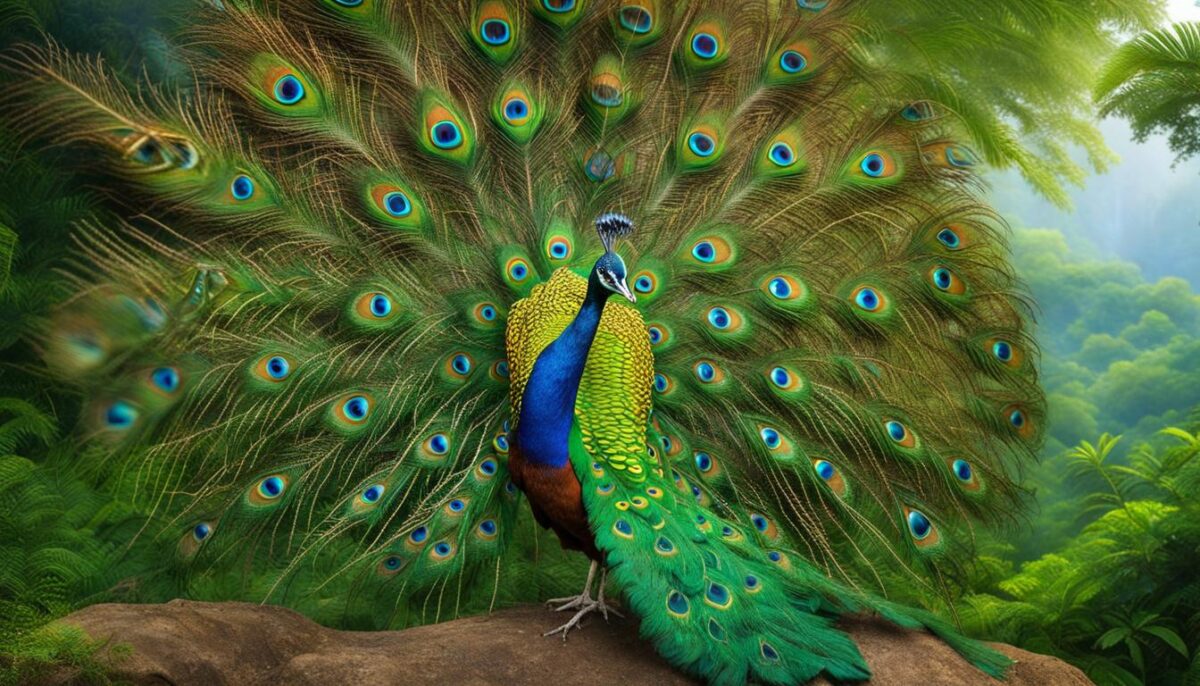
Peculiar Behaviors and Vocalizations
In addition to their courtship displays, peafowls engage in various other intriguing behaviors. They use vocalizations to communicate with each other, emitting distinct calls that serve different purposes. For example, male peacocks produce a loud, piercing call known as a “scream” to establish their dominance and warn other males to stay away from their territory.
Peafowls also display communal roosting behavior, where they gather in trees or elevated structures to rest and protect themselves from predators. This roosting behavior not only fosters a sense of community but also provides safety in numbers.
Interaction with Other Species
Peafowls are known to interact with other bird species in their habitat. They are often seen foraging alongside other ground-dwelling birds, forming mixed-species flocks. These interactions not only benefit the peafowls by expanding their foraging opportunities but also contribute to the overall diversity and dynamics of the ecosystem.
Intriguing and Diverse Behavior
The behavior and social structure of peafowls highlight their unique adaptations and complex social interactions. From their elaborate courtship displays to their vocalizations and communal roosting, peafowls exhibit a wide range of behaviors that contribute to their captivating world. Understanding these behaviors provides a deeper appreciation for the beauty and complexity of these extraordinary birds.
Conservation Status of Peafowls
Peafowls, with their breathtaking beauty and majestic presence, are not only a treat for the eyes but also an important part of our natural ecosystem. However, their conservation status raises concerns due to various factors such as habitat loss and hunting. Let’s explore the current conservation status of peafowls and the efforts being made to protect these magnificent birds.
Endangered Peacock Species
- The Green Peacock (Pavo muticus) is listed as endangered by the International Union for Conservation of Nature (IUCN). Its population has sharply declined due to habitat destruction and illegal hunting.
- The Java Peafowl (Pavo muticus) is also classified as endangered. It is endemic to the islands of Java and Bali in Indonesia and faces threats from habitat loss and hunting.
Vulnerable Peacock Species
- The Indian Peafowl (Pavo cristatus), also known as the Common Peafowl, is categorized as vulnerable. Despite being the most widespread and well-known peafowl species, it faces significant pressures from habitat degradation and hunting.
- The Congo Peacock (Afropavo congensis) is listed as vulnerable. Endemic to the Democratic Republic of Congo, this unique peacock species is threatened by deforestation and habitat fragmentation.
Conservation efforts are crucial to protect these endangered and vulnerable peacock species. Organizations and governments are working together to establish protected areas, implement strict anti-poaching measures, and raise awareness about the importance of preserving these magnificent birds and their habitats. By supporting these conservation initiatives, we can contribute to the long-term survival of peafowls and ensure that future generations can continue to marvel at their vibrant beauty.
| Peacock Species | Conservation Status |
|---|---|
| Green Peacock | Endangered |
| Java Peafowl | Endangered |
| Indian Peafowl | Vulnerable |
| Congo Peacock | Vulnerable |
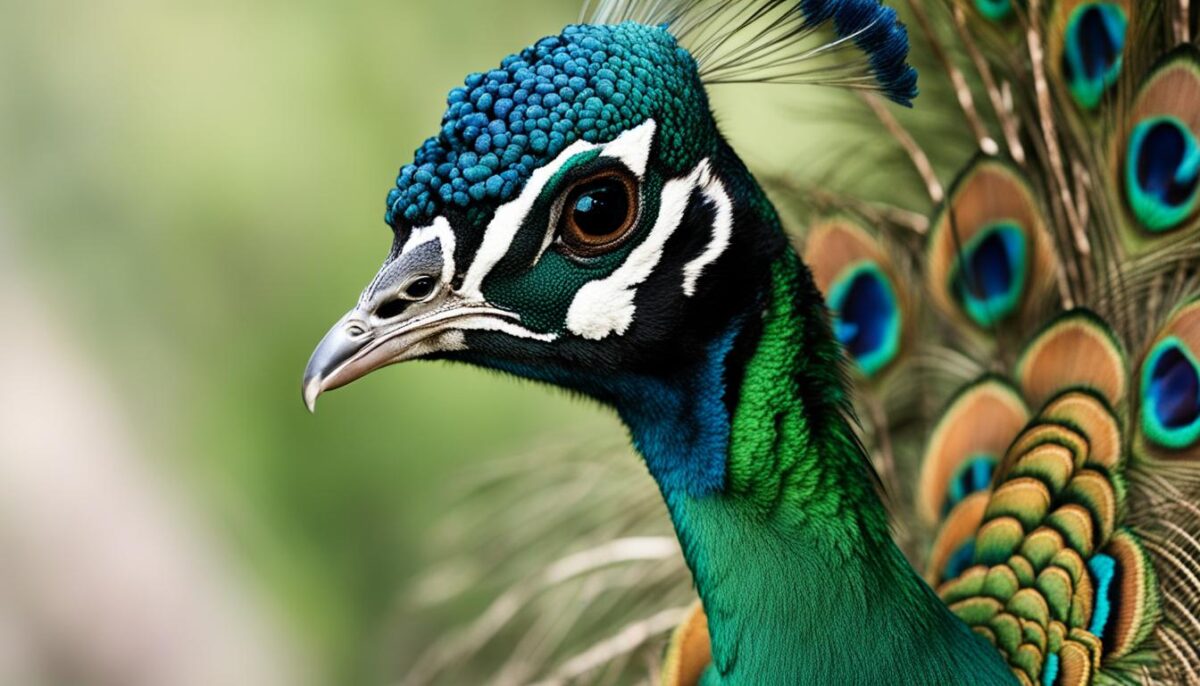
Peacocks as Symbols and Inspirations
The majestic beauty of peacocks has captivated humans throughout history, inspiring awe and wonder. These magnificent birds have become symbols of various qualities and concepts, carrying deep cultural significance in many societies. The rich symbolism associated with peacocks reflects their enchanting presence and remarkable appearance.
The Symbolism of Peacocks
Peacocks symbolize beauty, grace, and elegance. Their vibrant plumage, with its iridescent colors and eye-like patterns, represents the cycle of life and the interconnectedness of creation. In Hindu and Buddhist traditions, peacocks are associated with spiritual awakening and enlightenment. They are seen as sacred birds, embodying qualities such as wisdom, immortality, and protection.
In Christianity, the peacock is a symbol of resurrection and immortality. Its ability to regenerate its feathers and its association with the phoenix legend, which rises from the ashes, symbolize the triumph of life over death. Peacocks also feature prominently in Islamic art and culture, representing beauty, knowledge, and spiritual guidance.
Peacocks as Inspiration
The stunning beauty of peacocks has inspired artists, designers, and creators in various fields. The intricate patterns and vibrant colors of their feathers have influenced fashion, interior design, and artistic expressions worldwide. The graceful and regal presence of peacocks has inspired the creation of elaborate costumes, jewelry, and decorative motifs.
Peacocks have also served as muses for literary works, poems, and paintings. Their captivating form and symbolism have sparked the imagination of writers and artists, allowing them to explore themes of beauty, spirituality, and transformation. From ancient mythology to modern interpretations, peacocks continue to inspire and fascinate.
Inspiring the Human Spirit
Peacocks remind us of the inherent beauty and wonder that exist in the world. They encourage us to embrace our own unique qualities, to express ourselves boldly, and to appreciate the magnificence of nature. As symbols of resilience, grace, and divine connection, peacocks inspire us to live authentically and to embrace the vibrant colors of our own lives.
| Symbolism | Cultural Associations |
|---|---|
| Beauty and elegance | Hinduism, Buddhism, Christianity |
| Spiritual awakening and enlightenment | Hinduism, Buddhism |
| Resurrection and immortality | Christianity |
| Knowledge and wisdom | Islam |
| Inspiration for art and design | Global |
Conclusion
In conclusion, while baby peacocks may not display the same vibrant colors as their adult counterparts, they still possess their own unique charm and attractiveness. Their feathers may not yet showcase the mesmerizing hues that adult peacocks are known for, but hints of their future colorful plumage can be seen in the shades and patterns of their growing feathers.
Understanding the color genetics of baby peacocks helps shed light on the variations in their plumage and the factors that contribute to their eventual adult colors. As they mature, their feathers gradually develop, forming the iconic train that makes adult peacocks so stunning.
By exploring the behavior, social structure, and survival adaptations of peafowls, we gain a deeper understanding of the fascinating world they inhabit. Despite facing conservation challenges, peafowls continue to captivate us with their symbolic significance and inspirational impact on art and design.
Overall, the colorful world of baby and adult peacocks is a testament to the beauty and diversity of these extraordinary birds. Their vibrant feathers and unique characteristics remind us of the wonders of nature and the importance of preserving and appreciating their magnificent presence.
FAQ
Are baby peacocks as colorful as adults?
Baby peacocks have attractive hues in their feathers, but their colors are not as vibrant as adult peacocks.
How do baby peacock feathers look like?
Baby peacock feathers vary in shades and may have hints of their future adult colors.
What factors influence the color of baby peacocks?
The color of baby peacocks is determined by their genetics, similar to other animals.
What are the vibrant colors displayed by adult peacocks?
Adult peacocks showcase a mesmerizing array of colors, including blues, greens, and iridescent patterns.
What gives peacock feathers their vibrant colors and patterns?
The intricate microscopic arrangement of feathers and the presence of eye-like spots called ocelli contribute to the vibrant colors and patterns of peacock feathers.
Do different species of peafowl have different colors?
Yes, different species of peafowl, such as Indian Peacock, Green Peacock, and Congo Peacock, exhibit distinct colors and plumage.
How do baby peacock feathers develop and grow?
Baby peacock feathers gradually develop as they mature, eventually forming the iconic train feathers.
What adaptations do baby peacocks have for survival?
Baby peacocks rely on certain adaptations and behaviors to thrive in their environment.
What are some behavior patterns and social interactions of peafowls?
Peafowls exhibit intriguing behavior, including courtship displays and unique social structures.
What is the conservation status of peafowls?
The conservation status of peafowls varies, with some species being categorized as endangered or vulnerable due to habitat loss and hunting.
What is the symbolic significance of peacocks in human culture?
Peacocks hold symbolic meanings in various cultures and have inspired artists and designers throughout history.
Conclusion
Baby peacocks may not possess the same vibrant colors as adults, but they still showcase their own unique charm. Understanding the colorful world of baby and adult peacocks allows us to appreciate the beauty and diversity of these extraordinary birds.


